The Quest for the Real-Life Treasures of Atari’s Swordquest
In the 1980s Atari offered golden treasures as gaming prizes, most of which were lost to time. Until now.
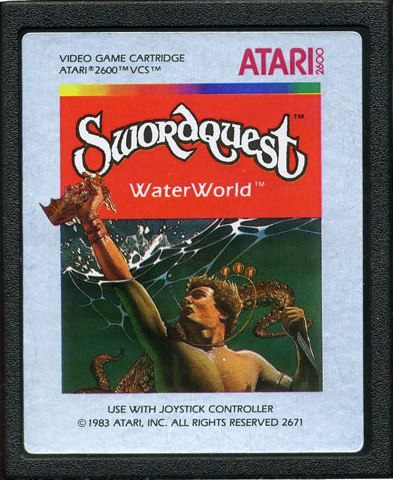
Whatever happened to the lost treasures of Swordquest? (Atari/Atari Mania/Used with Permission)
A solid gold sword. A diamond-encrusted chalice. A bejeweled talisman. Playing Atari in the 1980s, these were some of the prizes you could win—not delivered in pixel form on a screen, but as real-world treasures placed in the palm of your hand.
Atari commissioned five such prizes worth a total of $150,000, all to promote their new fantasy adventure game series, Swordquest. The Swordquest contest, one of the most audacious in video game history, offered players the chance to go on a digital quest for real treasure. They would follow a trail of esoteric clues from video game to comic book to live tournament, all for the chance to win real prizes valued at tens of thousands of dollars.
The contest began in spectacular fashion, but in the middle of it all, before all the prizes had been awarded, the whole thing was abruptly cancelled. The undistributed treasures seemed to disappear, their whereabouts a 30-year mystery. Until now.
Swordquest was an innovative, and ultimately aborted, series of fantasy adventure games that ran one of the most audacious contests in the history of gaming, asking brave players to follow a trail of esoteric clues from video game to comic book to a live tournament, all for the chance to win IRL quest prizes, like a large gem in a golden box or a jewel-studded crown of gold, each worth tens of thousands of dollars.
By the early 1980s, Atari, Inc. was at the pinnacle of its success. Dreaming big wasn’t a problem. The company ruled the burgeoning video game market, pulling in millions of dollars a year with its Atari 2600 home gaming system alone. One of the system’s most acclaimed games was a fantasy adventure called, well, Adventure. Released in late 1979, this game, filled with dragons with names like Grundle and Yorgle, quickly became a classic title, spurred on by its unique hidden clue known as the “Gray Dot.” This rogue pixel could be moved around to find a secret room that displayed the programmer’s name.
Atari historian Curt Vendel, co-author of the 2012 book, Atari Inc.: Business is Fun, told us that in the wake of this Easter egg becoming popular among players, “marketing thought it would be a great idea to create a series of games where players would have to find clues both in the game [and in its physical materials].”
This proposed sequel to Adventure was the project that morphed into the ambitious crossover event series, Swordquest.
In 1982, Atari was owned by Warner Communications, which happened to own a pair of other companies, DC Comics, and the Franklin Mint. As development on the Adventure sequel continued that year, the project began to expand, becoming a full-fledged crossover incorporating comic books from DC and bejeweled prizes from the Franklin Mint. With the help of game designer Tod Frye, who says he was, “pretty much the sole initiator and creative spirit behind the whole Swordquest thing,” the Swordquest mythos was born, incorporating elements of fantasy gaming, astrology, and the kabbalah, into a multimedia contest that was equal parts Willy Wonka and The Last Starfighter.

Behold the treasures of Swordquest. (Atari/Internet Archive)
The plan was to release a quartet of Swordquest games, each based around one of the four elements—Earthworld, Fireworld, Waterworld, and Airworld. Each game would come with a tie-in comic book that gave a more detailed telling of the game’s story than the pixelated graphics the Atari 2600 could achieve. These comic books would also hide clues that, if correctly deciphered, could earn a player entry into a final tournament.
The winner of each game’s tournament would receive a special treasure ripped straight from the pages of the comic, and brought to life by the Franklin Mint, with real gemstones and gold. The winner of the Earthworld tournament would win the “Talisman of Penultimate Truth;” the Fireworld contest would award the “Chalice of Light;” the Waterworld winner would earn the “Crown of Life;” and the champion of Airworld would be awarded the “Philosopher’s Stone.”
In addition to these prizes, the four winners would then compete for a final, ultimate prize: “The Sword of Ultimate Sorcery!” Each of the first four treasures was valued at around $25,000, while the sword was valued at $50,000.

The quest begins… (Atari/Atari Mania/Used with Permission)
The Swordquest series officially began in October of 1982 with the release of Swordquest: Earthworld. In the game, players moved through a series of rooms, each one corresponding to a Zodiac sign. They had to place specific items in each to uncover numeric clues that would point to word clues in the accompanying comic book. For instance, leaving the Grappling Hook in the Cancer room, and the Rope in the Leo room, would reveal the number clue “25 - 6.” This led players to page 25, panel six of the Earthworld comic book where the word “THE” was hidden within the background illustration.
The accompanying comic book, written by comic book greats Gerry Conway and Roy Thomas and illustrated by George Perez, told the tale of twins Tarra and Torr as they embarked on a quest to defeat the evil Tyrannus and collect the very same prizes that players were trying to win in the real world.
The comic included 10 different words hidden throughout its 52 pages. But the contest entry form only asked for five words. This final step was deciphered by noticing the words “prime” and “number” were colored purple in the comic book’s introduction. This clue indicated that only the words found on prime numbered pages were correct.
In the end, players who wrote in with the phrase, “QUEST IN TOWER TALISMAN FOUND” were awarded the title of “Supreme Sage of Sorcery” by Atari (people with three to four correct words were named “Wise Warrior,” and those with only one or two were dubbed “Brave Venturer”), and their names were entered in for a chance to join the final Earthworld tournament.
Earthworld sold around 500,000 copies, and around 5,000 players ended up submitting their answers to the final tournament. Of all those, only eight Supreme Sages of Sorcery submitted the correct words, granting them access to the competition. In May of 1983, the tournament was held at Atari headquarters in California. Each of the eight players was given a specially programmed version of Earthworld to complete in under 90 minutes. Stephen Bell, an unemployed 20-year-old from Detroit, took home the victory after he completed the game in just 46 minutes. Bell was given the Talisman of Penultimate Truth, a solid gold pendant inlaid with diamonds and other precious stones. It was also hung with a small, white gold sword.
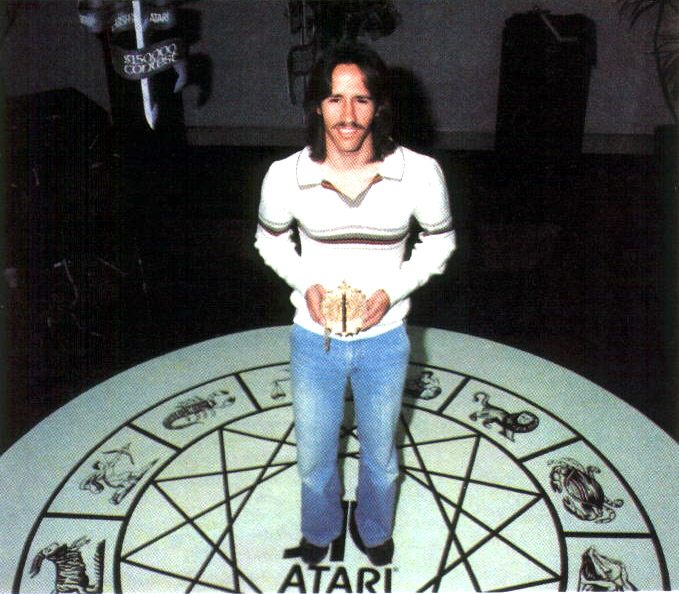
Stephen Bell and the Talisman of Penultimate Truth. (Atari Mania/Used with Permission)
For his part, Bell wasn’t so entranced by the fantasy of the prize. When asked what he was going to do with the $25,000 boondoggle, he said, “No plans yet. I didn’t really expect to win … Maybe I’ll get a car. I’ve never had one.”
By the time the Earthworld tournament concluded, the next game in the series, Fireworld, had already been on shelves for three months. Players were already on their way to conquering the second volume’s mysteries. Unlike Earthworld’s map, which was based on the houses of the zodiac, the layout of Fireworld was based on the Tree of Life from the Kabbalah. The gameplay was much the same as in the previous game. Players put items in specific rooms to get clues leading to the comic book, where Tarra and Torr continued their adventures.
Again, 10 words were hidden within the comic book, with only five of them being the correct ones. The meta-clue in the Fireworld comic book was the word “seven,” once again in the introduction, but this time called out by a different font. This indicated that only the hidden words found on page numbers adding up to seven were correct. For example, the word “leads” was hidden on page 16; 1+6=7. The winning phrase included the words “LEADS TO CHALICE POWER ABOUNDS.”

Can you find the hidden word in this shot from the Earthworld comic? (Atari/Internet Archive)
Unlike the small number of winners who had deciphered the Earthworld riddles, the response to the Fireworld puzzles was much larger. Again, Atari sent out certificates awarding honorary titles to everyone who submitted. Those with one-to-two words correct were named “Valiant Stripling;” those with three-to-four words correct were called “Master Pathfinder;” and those who had cracked the whole code were dubbed a “Knight of Chalice.” This time, Atari had so many winners that it had to whittle down the number of contestants, from 73 to a manageable 50, by having each Knight of Chalice submit a written essay about what they liked about the game.
With the field narrowed to 50, the Fireworld tournament was finally held in January of 1984. Like the previous competition, each player competed using a specially programmed version of the game at Atari headquarters. This time the contest was won by Michael Rideout from Aiken, South Carolina, who beat the game in 50 minutes using the knowledge of the Tree of Life he had garnered while dabbling in tarot. Rideout won the Chalice of Light, a fantasy-styled pimp cup made of gold and platinum, studded with diamonds, rubies, sapphires, and pearls.
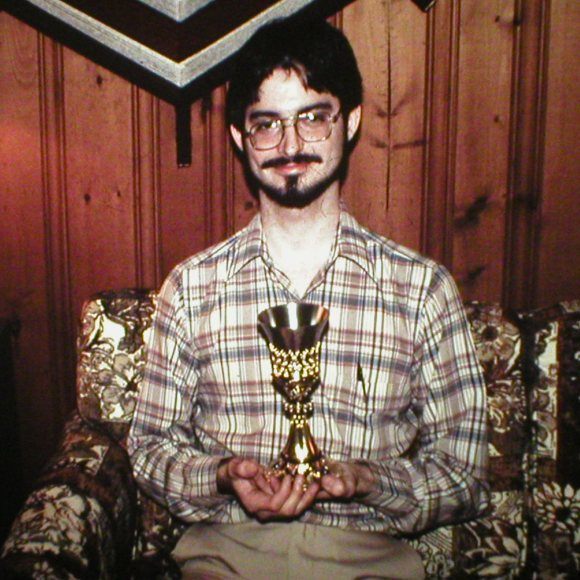
Michael Rideout and the Chalice of Light. (Atari Mania/Used with Permission)
Then came Waterworld, the third, and unexpectedly final installment of the Swordquest games. Unlike the previous games, Waterworld was given a limited release in February of 1984, being made available only to official Atari Club members who mailed away for the game. The layout of this installment was based on the seven spiritual chakras popular in New Age belief, making for a smaller map than ever before, with just eight rooms to explore. Once again, the clues pointed towards the comic book adventures of Tarra and Torr, this time looking for the words, “HASTEN TOWARD REVEALED CROWN.”
Unfortunately for the anxious Atari Club members who took the time to solve Waterworld’s puzzles, the entire Swordquest campaign was abruptly cancelled in the middle of 1984. Most of those who had already entered were told they didn’t qualify for the contest any longer (more on that below), and both Rideout and Bell were given $15,000 and an Atari 7800 as compensation for being unable to compete for the Sword of Ultimate Sorcery. Work had begun on both the game and comic book of Airworld, which would have been patterned after the I Ching, but neither was ever created, and the story was never finished. It seemed that Tyrannus finally won.

The meta-clue in the Waterworld comic book. (Atari/Internet Archive)
The contest’s cancellation was a result of Atari being purchased by controversial gaming CEO Jack Tramiel, and his new company Tramel Technology. The video game industry had been in a swift decline since 1983, and Atari had finally bottomed out by mid-1984, allowing Tramiel to purchase Atari Inc. and its intellectual property for a song. During this time, Atari’s various divisions were sold and reassigned. Somewhere in that tornado of business, the remaining treasures of Swordquest were seemingly lost.
In an interview in 2005, Rideout confirmed that he still had the chalice, which he kept in a safe deposit box. The fate of the talisman is a bit more murky, although in that same interview, Rideout says that he’d heard Bell had it melted down by a coin dealer for college money, only keeping the white gold sword. Vendel confirmed that Bell had in fact melted down the amulet for cash.
As to the Crown of Life that would have been given to the winner of the Waterworld competition, Vendel says that it was awarded, but during a semi-secret tournament, the winner of which has never been revealed. “Under contract, Warner was obligated to complete the contest for Waterworld, because players had submitted correct answers, and the game was sold to the public based on the fact that whomever solves the puzzle in the game would be awarded a prize,” says Vendel.
“They held a very quiet, non-public contest with the 10 people who solved the Waterworld contest. The crown was awarded to the third prize winner.” While we could find no hard evidence of this contest, Vendel says the contest had to take place by law.
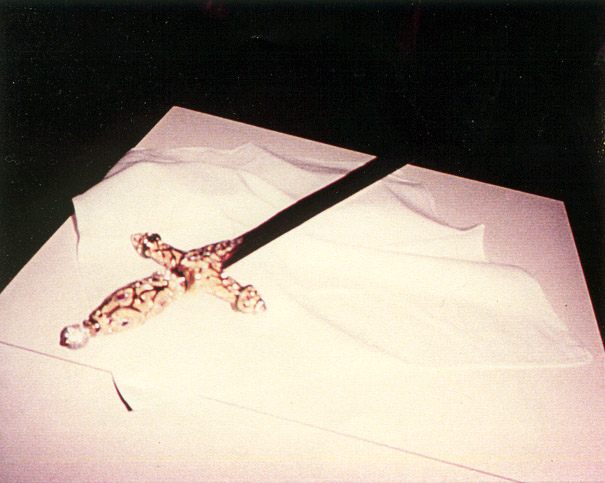
Is this the Sword of Ultimate Sorcery? (Atari Mania/Used with Permission)
Since Airworld was never completed or sold, that game’s contest did not take place. The Philosopher’s Stone and the Sword of Ultimate Sorcery were also thought to be lost, though Vendel says they were destroyed. The popular myth is that the remaining prizes were included in Tramiel’s purchase of Atari Inc., and that he held onto them—specifically, that the Sword of Ultimate Sorcery hung over Tramiel’s mantelpiece. (Tramiel passed away in 2012.)
Even lead designer Frye told us that he believed the prizes went to Tramiel. “As best I can determine, [the remaining] three prizes were part of the Atari assets, and were transferred to the Trameil family in ‘84,” he says. Vendel, however is vehement that this is all fantasy. “[What] did not belong to Atari, nor was purchased by Tramel Technologies were the Swordquest prizes, because they were owned by Warner Communications, and were being held by Franklin Mint,” he says. “They’re not sitting on Jack Tramiel’s mantel, nor is the sword sitting over Jack Tramiel’s fireplace. He never had the rights or access to the [prizes].”
According to Vendel, the rumor stems from an Atari employee who did see a sword over the mantel, but it was a family heirloom, not the Swordquest sword.

In the end, no one was able to grab the Sword of Ultimate Sorcery. (Atari/Internet Archive)
So what did happen to the Philosopher’s Stone and the Sword of Ultimate Sorcery? Vendel told us he got the scoop from a former member of Warner management. “Once Atari was sold, those prizes languished at Franklin Mint,” he says. “At some point Franklin Mint disposed of them. They were not retained, because why would they retain the prizes? It’s a lot easier just to smelt it back down and turn them into gold coins or other things they could sell.”
It seems that most of the lost treasures of Swordquest are just that: lost. But like with any great adventure there is still the glimmer of hope that the Crown of Life is still out there somewhere, awarded to some anonymous gamer who, all this time, has been a secret king.



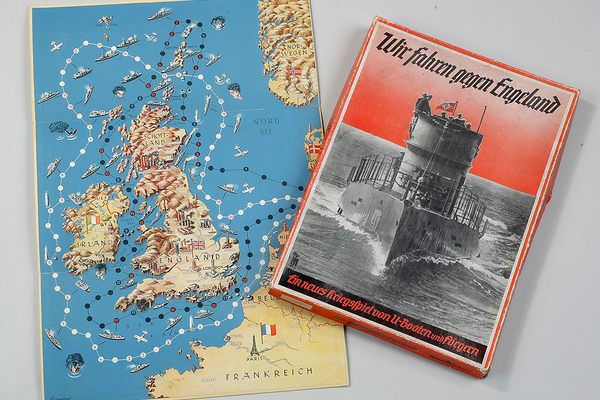



Follow us on Twitter to get the latest on the world's hidden wonders.
Like us on Facebook to get the latest on the world's hidden wonders.
Follow us on Twitter Like us on Facebook